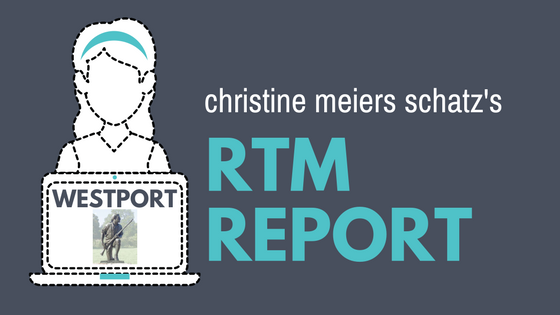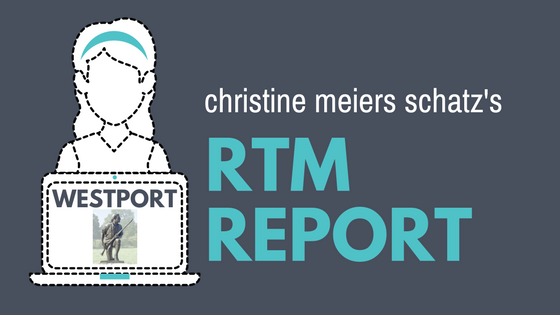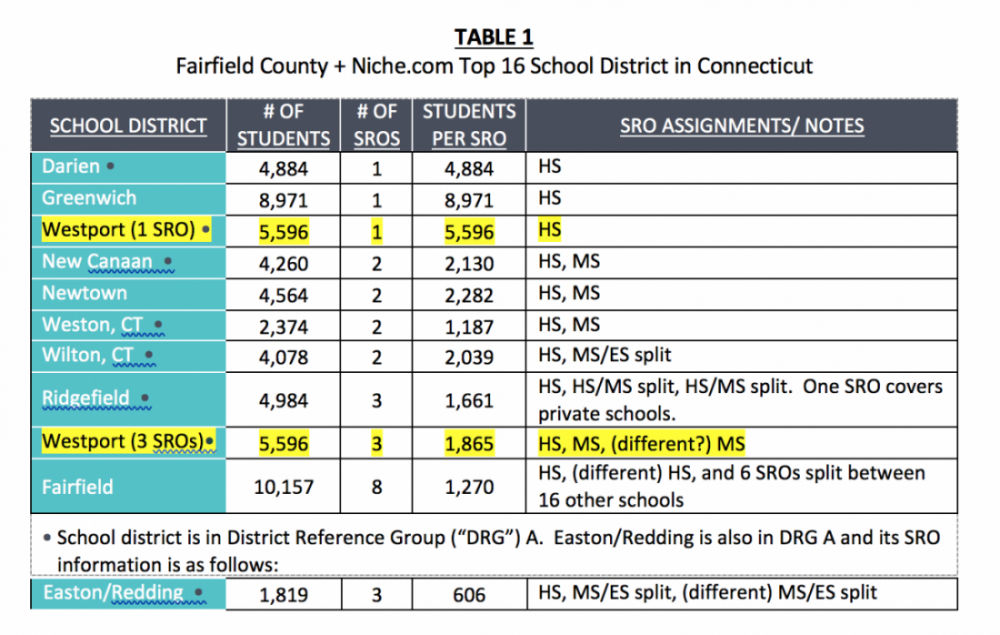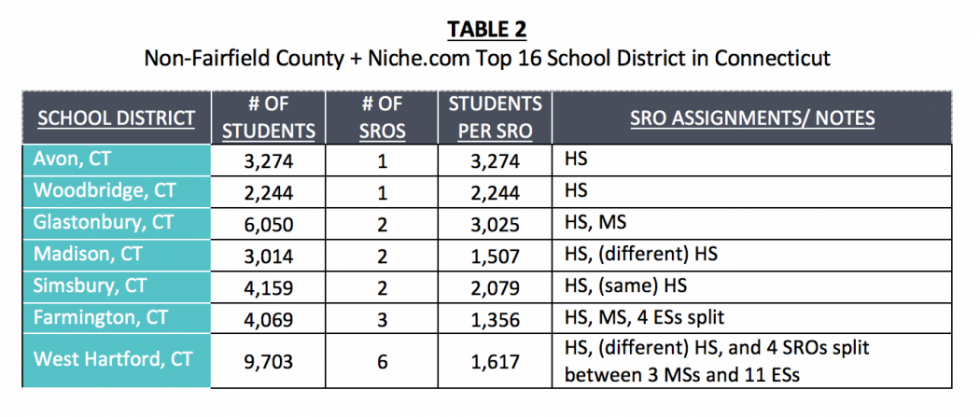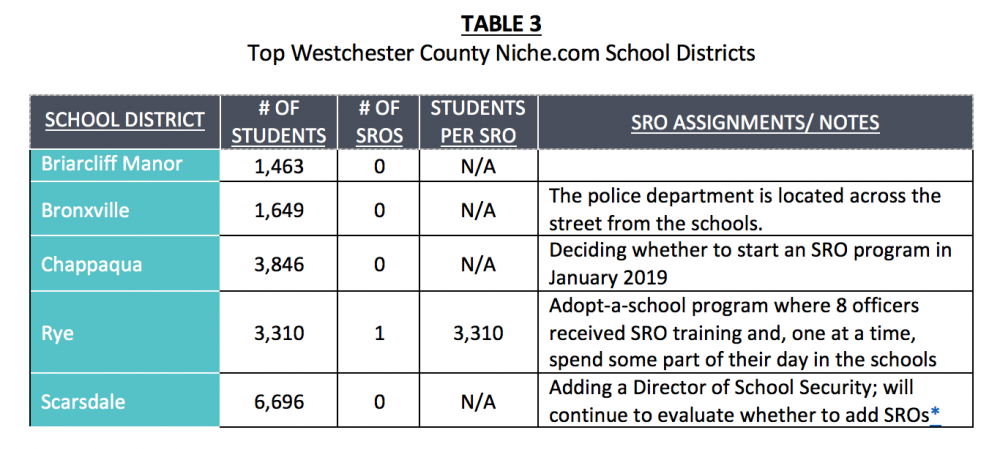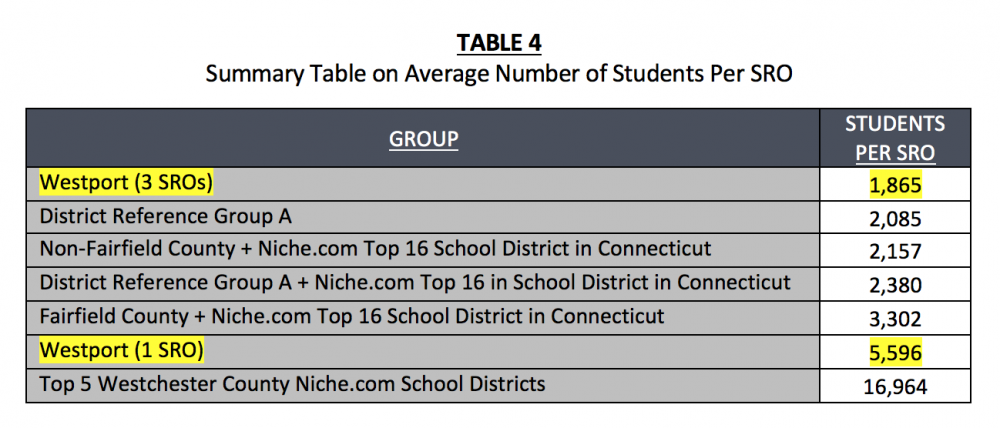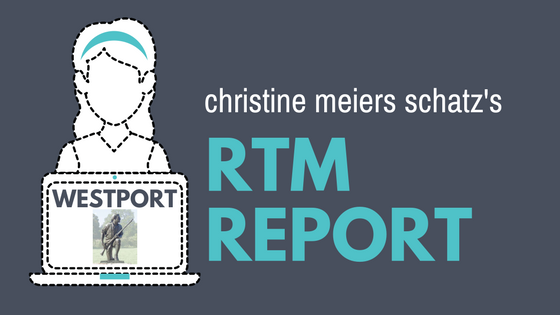Disclaimer: This is not an official communication from the RTM. Hopefully this goes without saying by now. Please see the full agenda summary to read the full disclaimer and summaries of the thirteen other agenda items.
AGENDA ITEM #2: Whether, by a vote of at least 70% of the RTM members present, to "overrule" the Board of Finance's denial of a $185,000 appropriation to the police overtime account to fund 2 School Resource Officers for the 2018-2019 school year. These officers would spend the majority of their time covering middle school students
There are numerous hyperlinks to research and other resources embedded in the text below. Sometimes I used an asterisk “*” at the end of a sentence where one might ordinarily use a footnote or an endnote. If you click on the “*”, you’ll be linked to the reference for the statement made in the preceding sentence.
The School Resource Officer (“SRO”) program began in Westport at the beginning of this school year with one SRO stationed at Staples High School. The appropriation at issue would enable the police department to add two additional SROs to cover middle school students during this school year. Because the Board of Finance (“BOF”) denied the appropriation request, approving it would require an affirmative vote of at least 70% of the RTM members present and voting.
The Board of Education and Police Department are expected to seek funding for all three SROs for the 2019-2020 school year through the normal, yearly budgeting process. By this time, it is anticipated that the Board of Education and town will have determined the long-term funding source for all three SROs.
WHAT IS A SCHOOL RESOURCE OFFICER?
According to the National Center on Education Statistics, a SRO is primarily an armed, career law enforcement officer, with sworn authority, that is assigned to provide security to a school.
The Congressional Research Service describes the roles of a typical SRO more broadly and breaks each down into three categories: (1) safety expert and law enforcer, (2) problem solver and liaison to community resources, and (3) educator. In a national assessment of SRO programs, SROs reported that they spend on average approximately 20 hours per week on law enforcement activities, 10 hours on advising and mentoring, 5 hours on teaching, and another 6 or 7 hours on other activities.
The duties of SROs can vary substantially from one community to another. To make sure all stakeholders are on the same page, experts recommend formalizing the SRO’s responsibilities in a memorandum of understanding* (a “MOU”) and collecting objective outcome measures, including data on school-based arrests, to ensure that, among other things, the program is not resulting in the increased use of the juvenile justice system for school-based minor offenses. (See, e.g., here, here, and here)
The Board of Education approved a MOU for the SRO program on September 4, 2018. The MOU does not assign responsibility to any party for collecting objective outcome measures or data regarding school-based arrests. It is my understanding, however, that there is a document listing some data that would be collected, even if responsibility for doing so hasn’t been assigned or formalized.
The SRO MOU includes fourteen bullet points regarding a SRO’s duties, and some of these bullet points are quoted below. As Dr. Palmer has explained at various meetings, the duties listed in the MOU fall into three categories:
- PROTECTIVE: SROs “[t]ake law enforcement action when necessary,” which includes providing trained, armed first response to all calls for service and/or safety hazards at assigned schools and de-escalating conflicts.
- PROACTIVE: SROs assess and identify both physical and interpersonal safety vulnerabilities in the schools and “[p]rovide safety and security training to staff.”
- PREVENTATIVE: SROs
- Create a physical presence during the school day that deters potential wrongdoing or potential wrongdoers from coming into the schools in the first place;
- Forge positive relationships with students, parents, and faculty so that these individuals will be comfortable going to the SRO to report potential security threats and provide other helpful information;
- “Present topics to students on various law enforcement/safety issues”; and
- “Assist the Superintendent, principals, other administrators, faculty, and staff in developing plans and strategies to prevent and/or minimize dangers situations that may occur on school grounds.”
Any SRO in Westport would receive 40 hours of initial training in topics including understanding the adolescent brain, communication strategies for working with adolescents, school law, how to work with special needs students, threat response, trends in adolescent drug use, social media and bullying, and how to establish informal counseling relationships with students.* The SROs would then receive at least 20 hours of additional training each year.
Some police officers are trained to wait for backup when responding to active shooters. If an SRO followed this protocol, there wouldn’t be any response-time benefit to having the SRO. According to Chief Koskinas, however, every officer in the WPD, including the officers that would be SROs, are trained and expected to respond solo to subdue an active shooter.
HOW PREVALENT ARE SROs?
The SRO program began in the 1950s, and it has grown in popularity in recent decades. Only 10 percent of public schools employed police officers as of 1997.* By comparison, as of 2016 and according to the best data available, approximately 22 percent of public schools had a full-time SRO and 21 percent had a SRO who was at the school part-time (meaning that the SRO is present at least once a week).*
Out of this same data set, high schools and schools with enrollments of over 1,000 were the most likely to have SROs present on a full or part-time basis. * Elementary schools and schools with enrollments of less than 300 were least likely to have SROs on campus.*
With some exceptions, these trends apply to top schools in our vicinity as well. As demonstrated in Table 1, there are between 1 and 8 SROs working at each school district in Fairfield County, and 12 of the 22 SROs cover high schools. No elementary schools have full-time SROs. By contrast, the size of the student population does not seem to be a reliable predictor of the total number of SROs in a school district. For example, Fairfield has 1,186 more students than Greenwich, but 7 more SROs. Weston has a significantly smaller student population than the other school districts, but 2 SROs.
For those curious, I went up to the “top 16” in the table above so that Newtown could be included. Because it is the only school district in Connecticut that has experienced a mass shooting, it seems like an interesting data point. Currently there doesn’t seem to be any SRO assigned to elementary schools even though, as you know, the mass shooting there occurred at Sandy Hook Elementary School.
At the other “top 16” Connecticut school districts that are outside Fairfield County (Table 2), and based on the most up to date data I could gather, 10 of the 17 SROs cover high schools. Out of the remaining 7 SROs, 2 cover middle schools exclusively, and 5 are assigned to cover, collectively, 3 middle schools and 15 elementary schools.
SROs seem to be less common in top school districts in Westchester County, though due to time constraints I wasn’t able to get as far down the Niche.com list of top school districts there.
SROs might be more prevalent in some areas of the U.S. than others, possibly for numerous reasons including state funding for the officers or whether a mass shooting has occurred at schools in the area. For example, the State of Virginia provides grants to fund both new and continuing SRO programs* and a mass shooting occurred at Virginia Tech University in 2007. And perhaps consequently, the percentage of Virginia schools with SROs is much higher than national averages - according to data from 2017, 87 percent of all high schools, 85 percent of all middle schools, and 34 percent of all elementary schools employ either full-time or part-time SROs, “with the great majority staffing at full-time levels.”*
The final table below demonstrates that Westport currently has fewer SROs per student than average amongst top schools in Connecticut. With 3 SROs, Westport would have more SROs than average amongst top schools in Connecticut.
The students/SRO metric isn’t exact because some students in a district aren’t monitored by SROs at all – this is especially the case with respect to elementary school students – but the metric seems to be commonly used for comparison purposes and is provided here for whatever it may be worth to the reader.
BACKGROUND REGARDING THIS APPROPRIATION REQUEST
When Dr. Colleen Palmer became Superintendent of the Westport Public Schools in 2016, she was surprised to learn that the district lacked a SRO program. In Dr. Palmer’s twenty-year tenure as a school administrator – including her time as Superintendent of the Weston School District – she had come to view SROs “as an integral part of an essential, powerful safety and security resource team.” In her opinion, the school district could not provide the “appropriate standard of care” to students without the SRO program.
At a Board of Education (“BOE”) meeting on October 23, 2017, Dr. Palmer and Police Chief Foti Koskinas proposed starting the SRO program slowly with one officer assigned to Staples High School for the 2018-2019 school year.
This proposal gained traction in the wake of the school shootings in Parkland, Florida and the lockdown that occurred at Staples High School on February 27, 2018. On this date, a student at Staples High School reported that she had overheard another student threatening to shoot a teacher.
Westport Public Schools use the VSTAG model of threat assessment and, as the model’s author, Dewey Cornell, has explained, “kids make threats frequently when they are angry, upset, or just trying to gain some attention… we have found that fewer than 1% of students seen for a threat assessment carry out their threats” (see here).
In following the pertinent threat assessment protocols, “investigators who talked to the youth determined that he had thoughts of committing a mass shooting at Staples and that there was a cache of guns similar to ones used in school massacres in his home.”* It was ultimately determined that the student lacked access to any firearms* – Lt. Jillian Cabana told the press that the student’s father was probably “one of the most responsible gun owners” around. The incident was serious enough in nature, however, that the student was charged with second-degree threatening.*
On March 14th, the Westport Public School District hosted a special presentation for parents regarding school security measures. Chief Financial Officer, Elio Longo, said that the 2013 Kroll Security Audit identified as one of its “high priority” items that the district should “consider” starting a SRO program.
At that time and following the recommendation of the audit, the pertinent school and town officials had considered starting a SRO program but decided not to do so because, purportedly, the former superintendent and the Westport Town/School Security Task force had not wanted to add any armed security on school campuses.
On March 26th, the BOE voted 5-2 to start an SRO program.
On April 17th, the BOE voted 6-1 to seek an appropriation that would allow the program to begin with three SROs for the 2018-2019 school year, with the understanding that one of the SROs would be funded through the reallocation of funds currently used for the town’s D.A.R.E. Officer. Among the three SROs, one would cover Staples High School and the other two SROs would spend the majority of their time at the two middle schools because “most threats are internal and come from the secondary schools.”
Dr. Palmer said that, among other reasons, she had increased her recommendation from one to three SROs due to the rapidly increasing lethality and frequency of school shootings. On subsequent dates she also explained that, when the SRO program was first proposed, the community may not have been amenable to a faster ramp up of the SRO program.
On April 18th the Board of Finance approved the First Selectman’s budget, which included funding for the D.A.R.E. officer that was expected to be converted into the SRO for Staples High School. The RTM approved this budget on May 7th.
On May 16th, First Selectman Marpe noted that a potential high school shooting in Illinois had been prevented that day by a SRO and informed the Board of Finance that the appropriation request to fund the two additional SROs would be fast-tracked. According to Mr. Marpe, a “significant portion of the population” supported the SRO program and some residents wanted the town to have eight SROs – one for each school.*
At the Board of Finance meeting on June 6th, Chief Koskinas and Dr. Palmer presented their funding request for the SRO program for the 2018-2019 school year. They explained that the additional two SROs would come from existing, experienced personnel at the Westport Police Department (“WPD”). The WPD would have hired two new, less experienced police officers to make the department whole again.
Some procedural snafus occurred and modifications were made to the form and total amount of the appropriation request. Ultimately, First Selectman Marpe requested a $260,000 appropriation to fund the program for the 2018-2019 school year. This amount represented the total cost of the two new replacement officers, who were more novice and received lower wages and benefits – and not the total first-year cost of the two more experienced officers that would become the SROs.
BOF member James Westphal estimated that the actual cost of each SRO – and not the less expensive replacement hires – would be significantly higher with a present value of over $5 million per officer. Police Chief Koskinas acknowledged that hiring these officers was a long-term commitment and that he was unlikely to downsize the officers once they were employed by the WPD.
On July 11th and August 1st, the BOF voted 4-2 against the appropriation. It was remarked that the BOF members had received little to no emails from the public in support of the appropriation. The four BOF members that voted against adding additional SROs explained that they were profoundly concerned about the safety of our students and that cost was not their primary consideration. Instead, they expressed concerns regarding the SRO program’s efficacy and potential downsides, including children becoming involved in the juvenile justice system for school-based minor offenses.
For those interested in learning more about these points, I’ve listed some articles below that are worth reading:
- Congressional Research Service, School Resource Officers: Issues for Congress, July 5, 2018
- Written Statement of Dr. Dewey Cornell for the Congressional Forum on School Safety, March 20, 2018
- Interdisciplinary Group on Preventing School and Community Violence, Call for Action to Prevent Gun Violence in the United States of America, February 28, 2018
- American Civil Liberties Union, The Origins and Consequences of School Policing, April 2017
- Washington Post, Opinion: Putting more cops in schools won’t make schools safer, and it will likely inflict a lot of harm, February 22, 2018
Board of Finance member James Westphal and Chairman Brian Stern cited research demonstrating that school shootings are incredibly rare – especially compared to other risks our children face, like death from automobile accidents, suicide, and drug overdoses. They suggested that, to the extent the town seeks to fund initiatives designed to keep our students alive and safe, perhaps resources should be focused more on those issues. This same data is shared in the first, second, and fifth sources listed above.
Board of Finance members Lee Caney and Sheri Gordon expressed the opinion that the town should wait to expand the SRO program and commit to new hires, if at all, until residents and elected officials have a chance to evaluate the results of the SRO program in its first year(s).
On September 13th, the Board of Finance held a special meeting to consider a new appropriation request for approximately $185,000 to fund the SRO program for the 2018-2019 school year – this is the appropriation presently before the RTM. The appropriation would enable the same two, currently employed WPD officers to become SROs, in addition to the one SRO that was already approved. In contrast to the prior appropriation requests, which involved employing new police officers, Police Chief Koskinas would assign overtime to existing officers at the WPD to cover the duties that the two additional SROs would have performed otherwise.
The BOF voted 5-2 against the appropriation, mostly for the same reasons.
In addition to the same concerns he expressed at the previous BOF meetings, Chairman Brian Stern added, “I don’t ever think I’ve ever seen a motion that has this long term of a financial impact without a statement as to how it will be funded in the long term.” He pointed out that those putting together the proposal had neglected to address other long-term issues as well, such as what the town should do when the preschools or other private schools request town funds for SROs to protect Westport students at their schools. (By way of background, one SRO in Ridgefield covers private schools.)
Board of Finance member Lee Caney suggested forming a committee and possibly even commissioning a follow-up Kroll report to come up with an all-inclusive and more thoroughly thought through proposal: “This is a very important decision for the town. Not only from a fiscal perspective but from a social perspective… Let’s slow down. Let’s not try for the win on this one. Let’s keep the one SRO in the high school. Let’s put a study together – we’re coming up on budget season. Let’s look at it, and then have a committee make a presentation based on evidence.”
Dr. Palmer wrote a memo addressing some of the BOF member concerns, which you can read here.
Following this meeting, First Selectman Marpe requested that the appropriation be added to the RTM agenda for October 2nd.
As mentioned previously, approving the $185,000 appropriation request would require an affirmative vote of at least 70% of the RTM members present and voting.
Click here to return to the summary for the other 12 agenda items.
Disclaimer: This is not an official communication from the RTM.
